cost of Fencing Panels Installation
Last updated 14th March, 2024
Want to know how much it costs to replace fencing panels?
In this guide you'll find a range of average fencing prices for different materials, sizes and styles - including 6 foot fencing garden panels (which average at around £1,500 all in) and 3 foot small fence panels.
Find out all about wooden fence installation prices below!
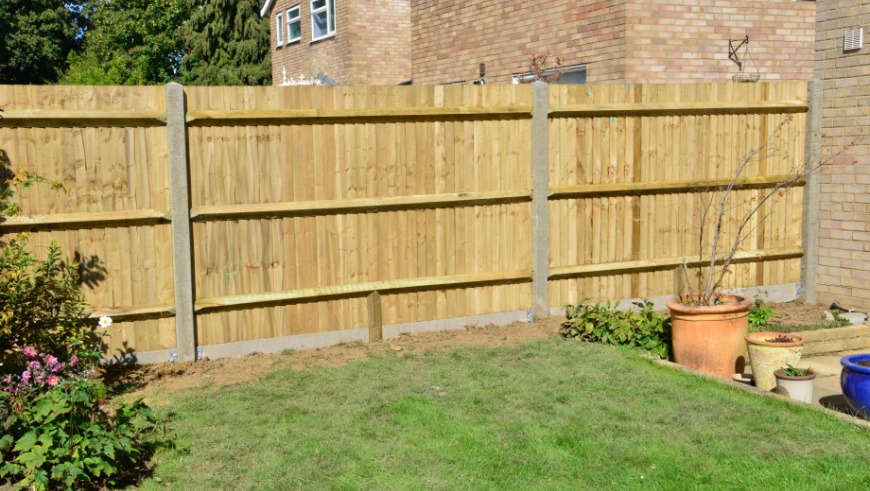
How Much Does Fencing Cost?
Let's get straight to it!
In order to provide an average cost for fence installation, we've looked at different prices across the UK for all the various types of materials so that any homeowner can estimate the cost for them.
But what exactly is included in fence installation costs?
Typically, this job would include 6ft high fence panels, concrete posts & gravel boards - as well as fitting them all too.
What type of fences are we talking about here?
You can choose from many different fence panel types, designs and materials (timber, metal etc.). The most popular designs include lap fence boards, closeboard panels, feather edge fence panels and overlap fence panels.
Just remember...
Depending on what type, material and size of fence panels you choose - the price can vary.
Read on to look at fence installation prices in more detail...
Table of Contents
- How much does fencing cost?
- Labour costs and time frames
- Choosing fence panels
- Timber fence panel costs
- Metal fence panel costs
- Composite fence panel costs
- Plastic fence panel costs
- Alternatives to fencing
- What is involved with installing fence panels?
- Can I install my own fencing?
- How much fencing do I need?
- Fencing maintenance and painting cost
- How to lower fencing costs
- Will new fencing raise my house value?
- Planning permission for fences
- Costs of removing fencing
- FAQs
- How to find & hire a fence installer
- Sources
Fence Panel Prices
The average cost to hire a tradesperson to supply and install 6ft fencing is typically around £1,500. This price can change depending on the material of fencing you choose.
So, what is the most popular fence material?
You've most probably already guessed it! The most popular fence material is wood.
Wood fencing is used in the majority of gardens across the UK. You can expect to pay £1500-£2000 on average to install wooden garden fences.
But are you looking for unique fencing?
If you'd like to splash some cash on your new fencing, metal fence panels are the most expensive but they are distinctive. There's a wide range of metals to choose from: iron, aluminium, and steel, for example. On average, metal fencing will cost between £1600-£2400.
Below are some estimated costs of hiring a tradesperson to install fences in an average UK garden, which is around 15 metres long. This would require an estimate of 8 fence panels measuring 1.8 metres in length and height:
| Fence Type | AVG. Installation Cost for 8 fence panels |
|---|---|
| Wooden fence panels | £1500-£2000 |
| Composite fence panels | £1200-£1700 |
| Metal fence panels | £1600-£2400 |
| Plastic fence panels | £1500-£1800 |
Fence Panel Supply Costs
We have collected the average supply costs of different types of fence panels in the tables below:
Wooden Fencing Costs
| Wooden Fence PANELs | AVG. COST per fence panel |
|---|---|
| Lap fence panels | £15-£25 |
| Feather edge fence panels | £40-£70 |
| Closeboard fence panels | £40-£60 |
| Double slatted fence panels | £60-£70 |
| Overlap fence panels | £30-£45 |
| Slatted fence panels | £30-£65 |
| Tongue and groove fence panels | £50-£80 |
Alternative Fence Panel Costs
For those who want to explore other fencing options, take a look at the following materials and their prices:
| FENCE MATERIAL | AVG. COST Per Fence Panel |
|---|---|
| Composite Fence Panels | £30-£40 |
| Metal Fence Panels | £26-£118 |
| Plastic Fence Panels | £20-£30 |
If you have any broken fences that may need repairing, you could consider a garden fence refitting. The price will depend on how many fences need replacing as well as the materials required. For a full refitting, you should expect to pay out at least £300.
Additional Costs
In this section, let's talk about any additional costs you might encounter...
While the basic materials make up the majority of the price, there are also added extras that you must consider. Fence installers may add on the following costs depending on your preferences:
Fence Post Costs
Fence posts are an essential part of the installation process with concrete and wood being the most popular choices.
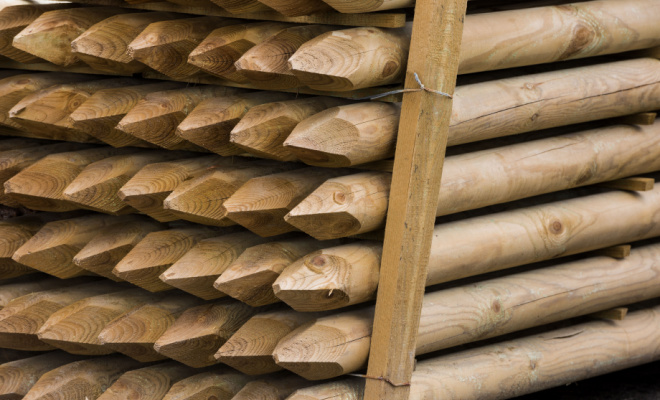
To help you decide which fence material is right for you, take a look at how much a fence post costs in the table below:
| FENCE POST MATERIAL | PRICE (per post) |
|---|---|
| Wood | £4 to £10 |
| Concrete | £20 to £40 |
What are the best fence posts to buy if you're on a budget?
Wood posts are the cheaper option, as they are lightweight, which will reduce labour and time frames as wood posts are easier to install, unlike concrete which is heavier and takes longer to fit.
Wood offers a level of sustainability, especially if you use pre-treated wood.
What if you're looking for a more durable fence post?
Concrete is the more durable of the two, because unlike wood, concrete is not biodegradable, therefore it is much less prone to rot or insect attacks. This offers complete protection against the natural elements, as concrete is strong enough to withstand adverse weather conditions.
When deciding on fence posts you also need to consider the different types, including regular, end and corner posts.
Below you can find a breakdown of the cost per post:
| TYPE OF FENCE POST | PRICE (per post) |
|---|---|
| Regular posts | £10 to £13 |
| End posts | £16 to £20 |
| Corner posts | £20 to £25 |
If you’re sticking to a budget, you may want to consider the lowest cost options. For example, if you require 8 fence panels for your back garden, then you would need 9 regular fence posts, which would come to a total of £90.
Fence Post Caps
What's the point of fence post caps?
To enhance the aesthetic of your garden fence!
You can choose a fence post cap, such as an acorn or a ball and collar, which can add something special to your back garden.
These are also great for security purposes, as they are adorned on top of fence posts, making it difficult for intruders to climb over. These can cost anywhere around £0.70 plus depending on the design you are after.
Gravel Boards
Wondering what a gravel board is and why you need them?
A gravel board is a panel made up of wood or concrete which is placed at the bottom of your fence panels to offer a better aesthetic.
It also acts as a protector against any rot or infestation.
How much can you expect to pay for them? Well...
Wood gravel boards are the cheaper option starting from £5, which offer a natural look on wooden fence panels.
While concrete is more expensive with the average price ranging from £13 to £20. This is because concrete is less likely to rot, meaning your fences will last a lot longer than they would with wood gravel boards.
Waste Removal
Do you really need to consider waste removal?
If you need your old fences tearing down, the majority of tradespeople charge for fence and waste removal. This amounts to an average of £400, although again this will be dependent on the amount being removed.
You can opt for DIY removal, however, it is a demanding task and will take up a significant amount of time, so you are best sticking with a professional who can do it in half the time.
Cost Breakdown Calculator
Individual costs of hiring a tradesperson to supply and fit 8 fence panels, including additional materials, labour and waste removal - Total Cost: £1500
Materials
£375
Tradespeople
£1050
Waste Removal
£75
Labour Costs and Time Frames
Now, it's time to look at labour costs and how long installing fencing will take!
In addition to the materials, a labour charge will be added onto your bill. While rates will vary with different companies, the average cost for labour for a back garden fence installation is between £1000-£1400.
But what can change labour costs?
The majority of fence installers charge by parameters, as the more material used the longer it will take them to complete the job.
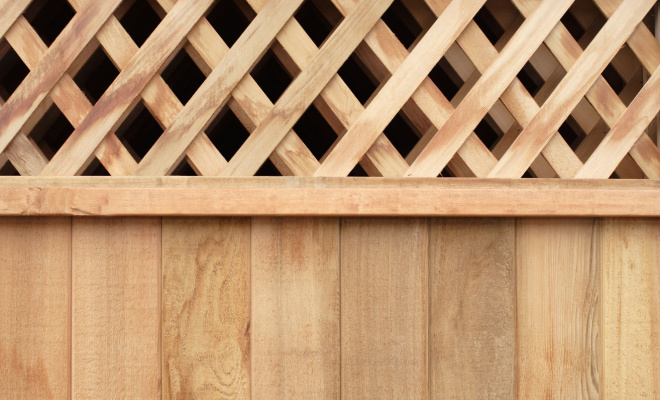
A tradesperson may also counter in your location in their price, as well as the time spent on the job.
Tradespeople may decide to work in pairs if a large number of fence panels are to be fitted, as this will allow them to complete the job quickly - this means you will be billed for multiple works rather than just one.
For more in-depth knowledge about the construction industry read this guide.
Choosing Fence Panels
If you're struggling to decide which fence is best, here is a list of different types of fence panels to help you make a decision:
Timber Fence Panel Costs
Timber fencing is by far the most popular material, and it comes in a wide range of styles to choose from.
It's also one of the cheaper options with fence panels starting from £15.
PROS
- ✔ Low-cost
- ✔ Sustainable
- ✔ Versatile
CONS
- ✖ Prone to decay
- ✖ Weaker than other materials
- ✖ Prone to swelling
- ✖ High-maintenance
Metal Fence Panel Costs
Metal fencing is great for security, but it's heavy to move and can be expensive.
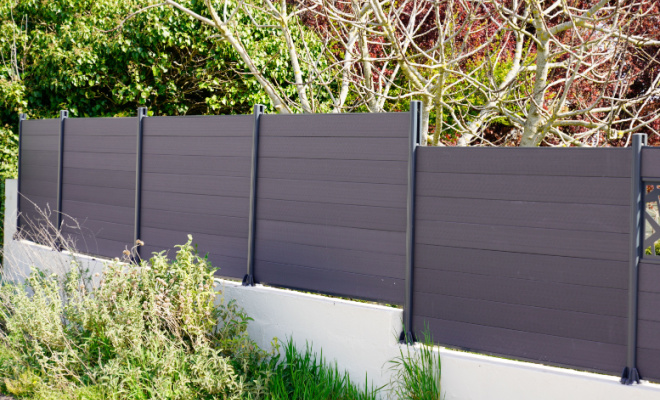
You can expect to pay up to £118 per fence panel.
PROS
- ✔ Long-lasting
- ✔ Safe for animals
- ✔ Durable
- ✔ High level of security
CONS
- ✖ Lack of privacy
- ✖ Susceptible to rusting
- ✖ Prone to swelling
- ✖ High-maintenance
- ✖ Expensive
Composite Fence Panel Costs
Composite fencing is becoming increasingly popular as it looks great and is easy to maintain.
They typically cost £30-£40 per panel, so they're a mid-range price.
PROS
- ✔ Long-lasting
- ✔ Rot-resistant
- ✔ Eco-friendly
- ✔ Less maintenance
CONS
- ✖ Subject to brittleness
- ✖ Expensive
Plastic Fence Panel Costs
Plastic fence panels are another option and are lower in cost than other types of fencing.
You can expect to pay from £20 per panel for plastic fencing.
PROS
- ✔ Low-maintenance
- ✔ Robust material
CONS
- ✖ Synthetic aesthetic
Alternatives to Fencing
If fencing isn't what you're looking for - check out these alternatives below:
Gate Installation Costs
So, do you need a gate with your new fence?
If you're updating your fences, you will need at least one gate to act as an entrance or exit.
The price of a gate will depend on the material you choose and where you want it to go. You can choose from a selection of different gate types or have a professional construct a custom-made gate for you.
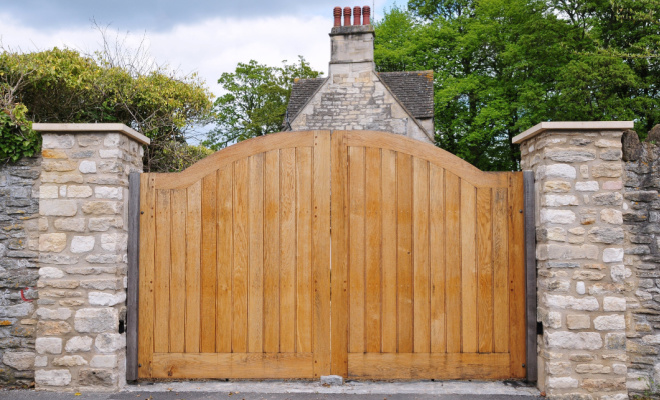
What needs to be considered when choosing a gate?
For the front of your property, you may want to choose something aesthetically pleasing like a decorative wrought iron gate, which will boost your kerb appeal. If you’re more interested in safety and privacy, you could invest in an electric gate for that extra level of home security.
To help you decide on the right gate for your home exterior, take a look at the estimated costs of having a gate installed.
| GATE TYPE | AVG. COST |
|---|---|
| Wooden garden gate | £180-£400 |
| Wrought iron gate | £1,500–£4,000 |
| Electric gate | £4,000-£8,000 |
Garden Wall Cost
Are you looking for a more traditional option?
Maybe a garden wall is best for you instead of more contemporary fencing. There are a variety of different options to consider such as the materials, the size of the wall, and more.
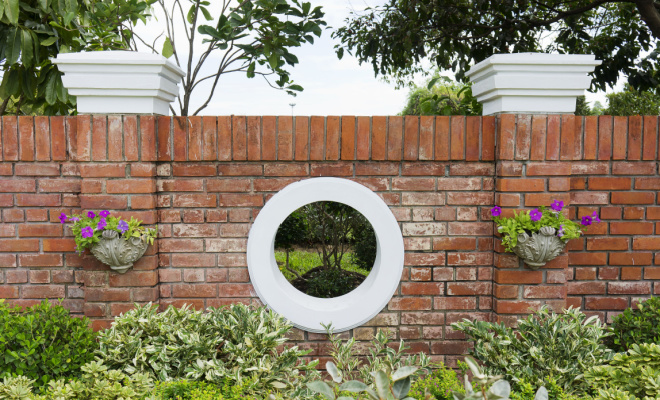
The most common garden wall is a retaining wall, which can be used for aesthetic purposes as well as a solution to sloping. Retaining walls can be built in a variety of materials to enhance your exterior landscape.
Here is a breakdown of the costs associated with different garden wall materials:
| MATERIAL | AVG. COST PER SQM |
|---|---|
| Brick wall | £50-£300 |
| Concrete wall | £40-£55 |
| Stone wall | £60-£150 |
If you'd like some help choosing which material is best for your wall - this is the most popular garden wall type...
All of the above materials are commonly used in both front and back gardens - stone is the most expensive of them all. Despite it being costly, it is also one of the most popular options.
What Does Installing Fencing Involve?
To help you understand what the job entails, here is a general breakdown of how a tradesperson will install your fence panels:
Treating the Area
This is an important step and this is why...
Before installing fence panels, it's important that the installer treats the area with weed killer and removes any vegetation before the installation process can begin. This is so it helps the installer see the whole area clearly.
If you have chosen wooden fence boards, they should also be treated to avoid any rot or insect infestations.
Preparing the Space
Once the area and the panels are prepared, the tradesperson will then start to mark out the space where the fences will be placed, making sure there are no visible cables or pipes in the way.
But what if you're just having your fences replaced?
If you’re having your fences replaced then they will just place the fences in the original spot if you’re happy for them to do so.
Digging the Holes
Pilot holes will then be made in the ground to make room for metal spikes which will be hammered in and levelled out to support the fence posts.
Are you wondering how big the holes should be?
No worries we've got you covered: The holes made should be 2ft wide and three times the size of your posts, so there is enough room to hammer them in.
The posts will then be inserted one by one and fixed with a layer of concrete or sand to avoid any movement. This should be left for at least an hour before the panels can be installed.
Added Extras
Any added extras you need to know about?
Before installing wood panels, the tradesperson may advise you to invest in treated gravel boards, as these will prevent the wood from touching the floor and rotting. Wire, iron and plastic fence panels will not need this treatment, as they are less susceptible to infestation.
Once this is complete, the securing process can begin by placing the panels or wire and securing them with post clips and stainless screws to avoid rust.
Levelling Out
And to finish it all off...
The tradesperson will then check if everything is level, and if not, they will cut the post tops to ensure that they are all even before securing a post cap in place.
Any extras such as post toppers or slates will then be added as well as any paint touch-ups that may be required.
Can I Install my Own Fencing?
Wondering if you can put up fences all by yourself?
Putting up fence panels is a pretty straightforward job that is well within the scope of a competent DIY enthusiast.
However...
It does require at least two people, as it is physically demanding with digging and plenty of sledgehammer work.
Before installing your own fencing, take a look at the following DIY tips:
Check for Permissions
Before you begin erecting a fence, it is important to be sure of your property boundaries.
But where can you find out your property boundaries?
You can find your property boundaires by checking the property deeds or consulting an expert. If you get this wrong your neighbour could force you to remove the fence. You can build a fence up to 2m without seeking planning permission but always check with the local planning office if you are unsure.
Watch Out for Wiring
Before you get that sledgehammer out - remember...
To check for any underground cables or pipes with a detector! Always use pressure-treated wood for your garden fence, as it comes already treated with wood preservative to prevent rot which saves you time when building a fence.
Cut Out Labour Costs
Installing your own garden fence will, of course, cut down your costs, as you will not have to pay out any labour fees So based on the average size garden of 50 foot long, you could save an average of £500, with labour rates of an estimated £10 per linear foot.
Professional Help
If you do not feel confident or knowledgeable enough about the installation process, you should seek out professional help, as a durable and sustainable fence is much more cost-effective and long-lasting.
How Much Fencing Do I Need?
The number of fence panels you require will depend on the size of the space where you want them installed.
The most common installation is 6ft-high wood fencing, which includes fence panels, fence posts and gravel boards. Take a look at the following table which will breakdown what you need based on the average size of your garden and how much it will cost.
| SIZE | PANELS | GRAVEL BOARDS | POSTS | COST |
|---|---|---|---|---|
| Small (10 metres) | 6 | 6 | 7 | £450 |
| Medium (15 metres) | 8 | 8 | 9 | £600 |
| Large (25 metres) | 14 | 14 | 15 | £1000 |
Fencing Maintenance and Painting Cost
Once the tradesperson completes the installation, it is up to you to keep on top of your fencing to make sure it lasts. If you choose plastic fence panels like vinyl or PVC then you will not be required to perform much maintenance, other than wiping them every so often.
But what type of maintenance does fencing need?
Materials like wood may need a bit more attention by cleaning it with a fence cleaner, which only costs around £6. In the case of fungus, you should consider replacing any diseased wood to avoid spreading.
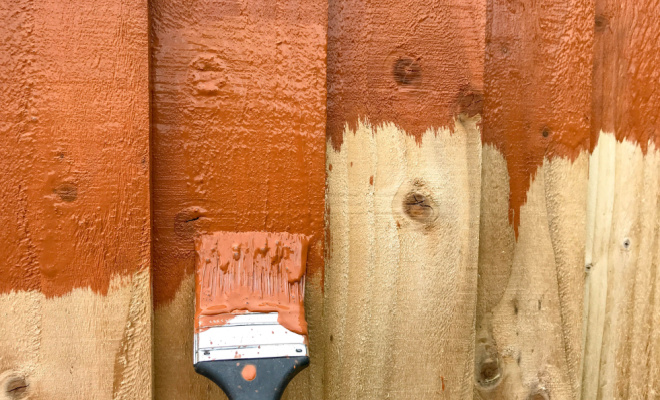
You may also need to repaint your wooden fence panels every couple of years to give them a freshen up, so it may be worth purchasing paint and primer, which will total an average of £30.
If you have a wrought-iron fence you will need to paint it every two to three years. You can do this yourself or get a quote from a professional painter who will make sure the job is done properly.
How to Lower Fencing Costs
If you have a budget...
You should consider different ways of cutting down your expenditure. To start, you need to think about why you are investing in fencing in the first place. Is it to protect your home or offer you more privacy? Or is it simply for aesthetic reasons? This will help you determine what you need rather than what you want.
You should also think about the materials you want to use, and possibly swapping them out for cheaper alternatives. For example, if you’re considering steel fencing, you could instead look at aluminium fencing which would cost around £60 per panel, in comparison to steel panels which are priced at an average of £250.
Another way of reducing down the price is...
By sharing fencing expenses with your neighbours, especially if you live in a terraced or semi-detached house where your back garden fences are joined. By splitting the cost, you could get opt for an expensive material for half the price that will last a long time.
Will New Fencing Raise my House Value?
Having a fence built in the front or back of your home may improve kerb appeal, as it will not only help to improve the aesthetics but will also make your property is secure and private.
If you are planning to sell your home, having an attractive-looking fence in your garden could boost your property’s value. This is why it is important to employ a professional to do the job, as this could help improve your chances of selling your house for a significant price.
Planning Permission for Fences
In most cases, you will not have to apply for planning permission to erect fencing.
However...
There are some exceptions, including:
- A fence over two metres or one metre high if you live near a highway.
- Your right to install a fence has been removed.
- The house is a listed building or your house is adjoined to one.
You should also be able to take down fencing willingly without having to apply for permission, unless you live in a conservation area.
If you have to apply for planning permission, then you may incur a service charge of £20.83 plus VAT. For listed building consent, you will not have to pay, however, for householder planning permission you could be charged up to £206 for submitting an application.
If you proceed with building a fence without the required planning permission, then you will have committed a planning breach. This can be a costly process, with fines of £20,000 or more being paid out by homeowners. To avoid expensive penalties, you should check with your local council before buying or erecting any fencing.
Costs of Removing Fencing
Before you make any final decisions on buying a new fence, the first thing you need to do is:
Get rid of your old fence!
You can remove it yourself, however, it is quite a big job, especially if you have a large amount of fencing to remove, so it will take up quite a bit of time.
If you decide to take the DIY route, then you would still need to consider costs. You could take it to your local tip for free, however, they may not accept fences that have been treated or painted, so you should check beforehand.
Another option would be to check if your council offer a bulk pick-up service, most areas do offer this with starting prices from £30 to have it taken away. You could also hire a skip; however, this can cost around £200 in the UK, which may not align with your budget.
The most common option is to hire a professional to remove your fences and take them away, which will save you a lot of time and energy. This will usually cost around £400 dependent on the type of material, as well as how much fencing you have.
Whether it is more or less, it is definitely worth paying for, as it means the quicker your old fences are removed the faster your brand new fences can be fitted.
FAQs
However, wooden posts are also more susceptible to rot and require frequent treatment/maintenance (though you can use concrete in post supports to keep the wooden post above ground to help prevent rotting).
Concrete posts, in comparison, are very secure even in strong winds, they will not rot and will last for decades. Out of the two, concrete posts are much more cost-effective, although they have a higher upfront fee of an estimated £20 per post, they are more sustainable in the long-run.
The downside of concrete is that not everyone likes the look of concrete and the fence panels themselves are not directly fixed to posts so they may rattle a bit in the wind.
Then, if the old fence posts are still standing, dig out the first and last posts of the run, then cut all the other posts as low to the ground as possible.
You don't normally have to dig out all of the old concrete post supports as you can stagger the new posts between them. However, if there have been many fences over the years, you may find a lot of concrete under the ground making it difficult to insert the new posts.
If this is the case, be prepared for a lot of hard work! If this all sounds like too much, taking the DIY route may not be for you, so instead you can ask the professional fitting your new fence to remove your old ones.
This would add on around £50 to the fence installation service, although this would be more if you have more than 8 panels to remove.
This helps to protect the fence boards (and posts) from timber rot and water damage. Some panels will come pre-treated, but if yours have not, then you will need to treat the panels immediately after the installation and keep treating them annually.
Pressure-treated timber is placed into a large vacuum then high quantities of timber preservatives are forced deep into the wood grain. This process helps to protect the timber against wood rot. Pressure-treated timber fencing does not have to be painted or treated so it is worth paying a bit extra when buying timber.
The price difference between non-treated and pressure-treated timber is around £5 per panel, so at such a low-cost it is definitely worthwhile. Do not get confused with dip treated fencing, this just protects the timber while in storage or during transit.
Dip treated timber still needs to be treated with a timber treatment paint after installation.
This could include a fee put in place in 2018, which requires you to pay around £20 plus VAT to apply for planning permission, so make sure you check before you go ahead with the application.
If you are unsure about whether you need planning permission, It costs nothing to quickly check with your local planning department so always contact them if you are unsure. You do have to be careful about the property boundary, however, as this is a source of many neighbourly disputes.
If you have the front of a fence facing towards your garden - that's your fence. But if in doubt - look at the deeds to your property.
How to Find & Hire a Fence Installer
If you're looking for a professional fence installer, it's important that they have experience. Ask for examples of previous work, and you can also ask for references too.
Don't choose the first fence installer you find; look around and ask for quotes from various companies.
Sources
https://www.planningportal.co.uk/info/200130/common_projects/20/fences_gates_and_garden_walls
https://www.gardenersworld.com/plants/nine-ideas-for-garden-walls-and-fences/
https://www.housebeautiful.com/uk/garden/a36491939/garden-screening-ideas/
https://www.gardendesignexperts.com/size-guide/
https://www.atozqualityfencing.com/faq/










